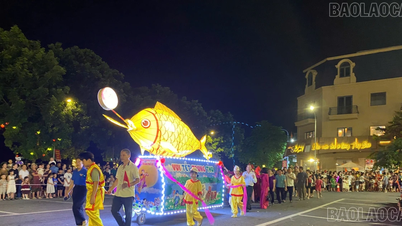When the soundtrack "leaves the movie"
Recently, the soundtrack song for "Red Rain" performed by Hoa Minzy titled Pain in the Middle of Peace (composed by Nguyen Van Chung) attracted more than 1.8 million views. The song was played at the end of the film when the image of two mothers scattering flowers on the Thach Han River, making the emotions in the chorus even more multiplied among the audience in the theater.

After the film was released, according to digital music statistics website Kworb , the music video was the most viewed video on YouTube Vietnam in the past 24 hours, and also entered the top 20 global MVs on this platform.
Hoa Minzy plays the role of a wife whose husband participated in the 81-day and night battle to protect Quang Tri Citadel . Director Nhu Dang included some scenes from the movie " Red Rain" , such as the scene where Squad 1 opened fire to fight back when the enemy swept in, and a comrade stroked the eyes of a soldier who had just fallen.

The song was well received by listeners for its lyrics and melody, along with the touching story in the MV. Many viewers said that when the song played in the theater at the end of the film, they cried for the mothers and wives of the soldiers who remained forever on the banks of Thach Han.
Director Dang Thai Huyen chose the song as the main song for the film because she appreciated its humanistic message and Hoa Minzy's emotional voice. In an interview with the press, she said she believed the song would have its own life, strong and long-lasting.
In the past, there were many soundtrack songs that were sought after by audiences even before the movie was released. For example, the movie " Zippo, Mustard and You" ordered 3 separate songs before its release to create a media push. Some outstanding soundtrack songs are remembered by audiences longer than the movie: The song " You" was once forgotten by people, but the melody still resonates in their memories.
Many filmmakers believe that composing music for television dramas is getting more attention - many film projects are willing to spend money to order 3-4 songs to increase their popularity. However, there is still a paradox between quality and budget: Sometimes musicians are only paid 1.8 million VND/episode (for background music + arrangement + singer), causing many people to stay away from composing music for films.
It is worth noting that many soundtrack songs continue to live on strongly after the film ends. ZNews page lists 10 outstanding soundtrack songs such as " Farewell to the Past" , " Old Memories" , " Where Love Begins" - these songs continue to be listened to decades after the film has faded into the past.
Recently, a typical example is the song " Going in the middle of a brilliant sky" , the soundtrack of the movie of the same name composed by Ngo Lan Huong. This song was not only praised for its emotions, but also spread strongly on social networks - more than 53,000 TikTok videos used this song. At that time, the song "escaped the movie" to become an independent music product, performed at many events.
In the new film music section, the song " Mot Minh O Day" from the film " Ut Lan: Oan Linh Giu Cua " composed by Bui Cong Nam, performed by Bui Lan Huong, is also proof of "escape from the film". When the film was released, the song was introduced in advance, creating a media effect; many audiences looked for the song before even knowing about the film.
The trend of "movie soundtracks escaping from movies" is not limited to traditional movies; with the development of online movies, web dramas, streaming, many OSTs (Original SoundTrack) are the original music of a movie or TV show, released in advance to stimulate curiosity, "tease" the movie - a method similar to releasing a music video before the movie premieres. This is an example of how music and cinema coexist, supporting each other to spread deeper into the audience's lives. Therefore, it can be said that, when positioned correctly, movie soundtracks can become official music products, leading the market, spreading emotions much stronger than when they were only associated with movies.
New trends in film music
Film music is no longer just a "background" but is becoming a strategic element in film production - from custom orders, remastering old songs to investing in careful arrangement and background music.

For example, director Trinh Dinh Le Minh once shared with the press that, for TV dramas, he often puts the background music and theme song in parallel with writing the script, choosing emotional passages so that the music resonates appropriately. Film music in Vietnam now not only "speaks for" the images, but also serves as the main emotion for viewers to remember each scene.
In the TV series segment, the song " Pain in the Middle of Peace" ( Red Rain ) was released at the same time as the film, creating a push to attract attention - when the audience enjoyed the film and searched for the song. Film music now does not wait for the film to be released but is part of the communication strategy.
Collaborating with famous artists, making professional music videos, performing OSTs (original soundtracks) in non-film events - all have become familiar. In addition, many films use old, famous music to refresh, bring nostalgic emotions into the film, and increase recognition. For example, the soundtrack of " Zippo, Mustard and You" ordered many new songs but also combined familiar background music to create emotional connections.
Another new trend is the support of digital platforms, social networks and technology. Movie soundtracks can now go viral on TikTok, YouTube, Spotify - spreading beyond cinemas and television. Producers often release the original OST of the movie soundtrack before the movie is released in theaters to "test tastes", evaluate feedback and adjust the media campaign. The song " Going in the middle of a brilliant sky" is proof: After releasing the OST, the song spread strongly through social networks, contributing to attracting moviegoers.

Along with that, film music production is also becoming more and more professional: Musicians not only write theme songs but also compose background music throughout the film, meticulously arrange the music, and master the sound to suit a variety of viewing platforms (TV, theaters, streaming). However, there is still a paradox: Many projects set film music prices low compared to the effort. Musician Xuan Phuong once shared with Thanh Nien Newspaper that he had to research each episode, write dozens of musical pieces, compare scenes to choose the right music at the right time - a seemingly simple but very hard job. And because of that not-so-small investment, film music is being promoted by filmmakers before the film is released.
Vietnamese film music is gradually taking shape as an independent, methodically and professionally invested stream. Pre-release to create effects, strong spread through digital platforms, and the trend of combining with popular music have opened up a clear symbiotic value. If we continue to focus on improving the quality of composition, arrangement and exploitation of background music throughout, Vietnamese film music can completely reach international level in the future.
Source: https://baonghean.vn/nhac-phim-xu-huong-va-gia-tri-cong-sinh-10307698.html


![[Photo] Prime Minister Pham Minh Chinh launched a peak emulation campaign to achieve achievements in celebration of the 14th National Party Congress](https://vphoto.vietnam.vn/thumb/1200x675/vietnam/resource/IMAGE/2025/10/5/8869ec5cdbc740f58fbf2ae73f065076)

![[Photo] Prime Minister Pham Minh Chinh chairs the Government's online conference with localities](https://vphoto.vietnam.vn/thumb/1200x675/vietnam/resource/IMAGE/2025/10/5/264793cfb4404c63a701d235ff43e1bd)
























































![[VIDEO] Summary of Petrovietnam's 50th Anniversary Ceremony](https://vphoto.vietnam.vn/thumb/402x226/vietnam/resource/IMAGE/2025/10/4/abe133bdb8114793a16d4fe3e5bd0f12)

![[VIDEO] GENERAL SECRETARY TO LAM AWARDS PETROVIETNAM 8 GOLDEN WORDS: "PIONEER - EXCELLENT - SUSTAINABLE - GLOBAL"](https://vphoto.vietnam.vn/thumb/402x226/vietnam/resource/IMAGE/2025/7/23/c2fdb48863e846cfa9fb8e6ea9cf44e7)



































Comment (0)